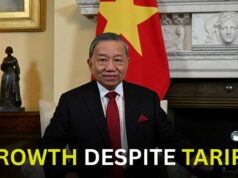NEW DELHI: There was a strange disclaimer by the U.S. Federal Communications Commission a few days ago. It said: “5G technology does not cause coronavirus”. That the top U.S. agency charged with regulating all internet, television, radio and satellite communication had to come out with a disclaimer of this kind tells you something about the shock and awe the coronavirus has generated, even in those countries with no 5G.
Fortunately, although part of the latter, India did not see any such panic. This is important as the country is all set to launch 5G trials as and when the coronavirus eases. But more important, early last month, Reliance Jio approached the government requesting permission to test its own proprietary 5G technology and design. And in February, the International Telecommunication Union approved an India-developed 5G design for use in rural areas.
Let’s begin with Reliance since it’s of enormous strategic import. In March 2020, the pink papers reported that Mukesh Ambani’s Reliance Jio had sought government permission for testing its in house 5G technology and designs in the forthcoming 5G trials. The Economic Times reported that this was probably the first time that a mobile phone company had developed such technology to replace external equipment providers (Oracle and Nokia).
The paper quoted an unnamed Reliance executive as saying that “We are more scalable than these vendors and are fully automated since we have our own cloud native platform. In 5G we will be totally self-sufficient. We can give the design, layouts, board support packages to third party manufacturers to have our gear made.”
The report set Twitter on fire with some Tweeple recalling Reliance Chairman Mukesh Ambani telling U.S. President Donald Trump during his India visit in February that “We are going to do 5G. We are the only network in the world that doesn’t have a single Chinese component.”
But to be fair, Ambani had given enough hints over the last few years about his 5G ambitions. In October 2018 he had told the Indian Mobile Congress that “By 2020 India will be a fully 4G country and ready for 5G ahead of other countries.”
And last year at the annual general meeting of Reliance in August, Ambani spelt it out: “The core and aggregated layers of our converged network are 5G ready today and because of our early adoption of enhancements to LTE our wireless tech is already 4G + and we can upgrade this to 5G at minimal incremental cost. Thanks to Jio’s Converged Network Architecture, we can offer even faster fixed broadband to homes and business establishments today.”
But more of that later. In February 2020, the International Telecommunication Union approved a 5G standard for use in rural areas. The standard has been developed by the Technical Standards Development Institute, India (TSDI), an autonomous body bringing together industry, manufacturers, R&D organisations and academia.
The design based on 3GPP technology, is described as “Low Mobility Large Coverage” and is specifically designed to meet the 5G requirements of India’s vast rural hinterland. It exploits a new transmit waveform that increases the range of cell towers, has high spectrum efficiency and improved latency. It is expected to usher in a digital revolution in the countryside by ensuring it remains in step with urban India as the 5G transformation sweeps in.
Now here come the caveats. For the rural 5G to succeed, ideally Reliance Jio should support it, says Prof. V Kamakoti of the National Security Advisory Board. “But Reliance has not revealed any larger thinking behind its 5G plans nor has it come out with details of its technology and design,” he said. Then again, chipsets will continue to be imported because India lacks adequate fabrication facilities.
But there’s no doubt an indigenous 5G solution would solve many of India’s security dilemmas given that the main players currently are foreign companies. TRAI Chairman RS Sharma said recently, “If you have your core network coming out from somebody else and you don’t know what’s happening inside, that’s the best way people can get all your information. Therefore, it is strategically important to have control over that.”
Two years ago, TRAI recommendations had called for “Net zero imports of telecom equipment by 2022.”
TRAI was pointing to a major weakness in India’s telecom infrastructure, notably the dominance of foreign firms. China’s Huawei, for instance, has a strong presence in the telecom equipment and mobile phone market, and considers itself a natural 5G choice. It has tie-ups with Airtel, Vodafone and BSNL, all top telecom operators. Nor can it be denied that Huawei’s 5G technology is not only a market leader worldwide, it is also considered the most affordable. But is it good strategy to allow Huawei a stake in India’s 5G when China remains an adversary?
Kamakoti believes the indigenous route is the best option for India, even a limited indigenous 5G. In his view, “India can import chipsets but carry out the integration in India, and the software can be Indian. This ensures our control of the source code and our major security concerns are taken care of. So it will be good if Reliance works in that direction.”
Expect the MNCs to come out strongly against India’s indigenous effort since it could well limit their prospects in the world’s biggest market. That effort will in all probability be driven by their large pool of Indian employees. But the larger benefit for India to have its own homegrown 5G is a strategic advantage that any government would want to have.
End piece: Take a close look at the recent amendment to clause 10d of the public procurement order of the Department of Telecom. It says if any foreign government restricts or excludes Indian bidders, India will do the same to bidders from that country seeking orders here. It helpfully listed eight categories of foreign-made telecom equipment entering India that will be targeted under the new rules. It’s not clear which country (or countries) has fallen foul of this rule but if it boosts ‘Make in India’, why not.
Thirty eight years in journalism, widely travelled, history buff with a preference for Old Monk Rum. Current interest/focus spans China, Technology and Trade. Recent reads: Steven Colls Directorate S and Alexander Frater's Chasing the Monsoon. Netflix/Prime video junkie. Loves animal videos on Facebook. Reluctant tweeter.




